
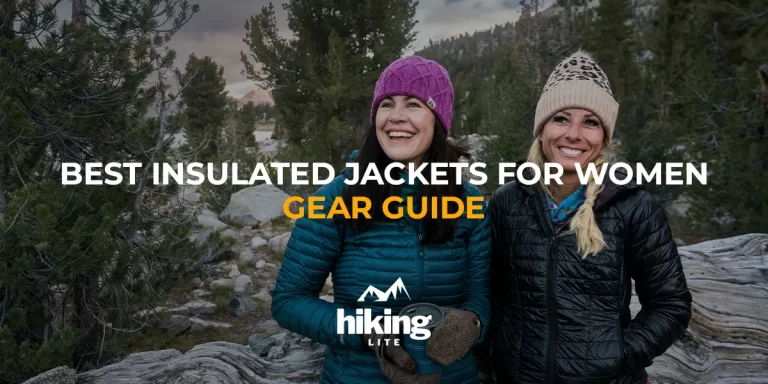
When heading into the backcountry, your layers make all the difference in battling the unpredictable elements in comfort.
But keeping warmth without bulk is key for enjoying adventures without extra pounds pulling you down.
This guide will take you through the top ultra-lightweight insulated options for women that maximize heat without mass.
From trusted brands to innovative new designs, read on for our picks of the lightest and most effective insulated jackets perfect for keeping pace with any active hiking schedule.
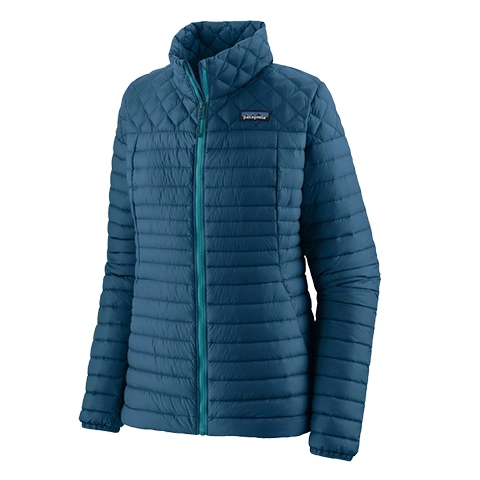
Key Specs
Weight: 7.65 ounces (217 grams)
Material: 10D nylon ripstop
Price: $$$
PROS
✅ Ultralight
✅ Comfortable
CONS
❌ Thin pocket lining
As the weather cools, a lightweight layer is essential for staying comfortable on the trails. The AlpLight Down Jacket from Patagonia caught my attention with its great warmth-to-weight ratio.
Made from recycled nylon, this piece packs down smaller than expected for its capabilities. The down insulation provides generous heat without excess bulk.
However, some users report the collar fitting closely. Personally I found the fit otherwise quite roomy. The one drawback is lack of insulation in the hand-warmer pockets. Still, for active use, this flaw is minor.
After many mountain adventures, the jacket has maintained its loft. Weight-wise it hardly makes a difference in my pack either.
Overall the eco-materials, compact size and reliable warmth deliver excellent value. Though not flawless, for lightweight hiking layers the benefits far outweigh one small complaint.
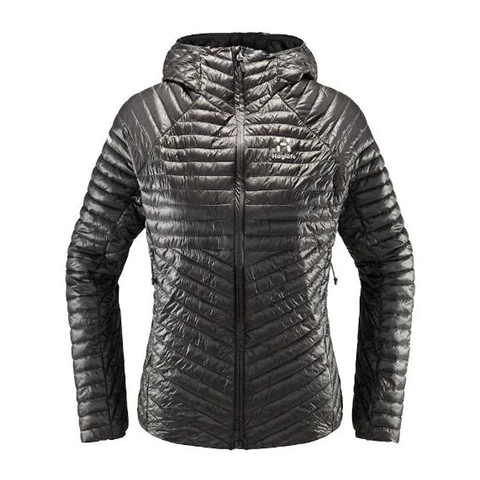
Key Specs
Weight: 10.93 ounces (310 grams)
Material: 10D polyamide (recycled)
Price: $$$
PROS
✅ Durable
✅ Sustainable option
CONS
❌ Relatively expensive
❌ Limited availability
I was eager to test the Haglöfs L.I.M after reviews raved about its warm-yet-portable design.
Unrolling it from its tiny stuff sack surprised me – how could something so compact deliver? But the Mimic and graphene promise performance too good to doubt. Constructed from a breezy 10D fabric, it feels flimsy yet tough like good hiking kits should.
Zipping in, toasty warmth hugs my skin without suffocating sweatiness. Even after long treks, the loft maintains like the first day. Its form-fitting cut plus stretchy bits flow freely with movement too. Solo in serious chill it may falter, but paired appropriately it truly shines.
Versatile pockets store essentials while ventilation prevents overheating on climbs. Best of all, the trim packaging means packing light without comfort compromises. Though pricey for some, its value shows.
For rugged adventures requiring minimal baggage yet maximum protection, the L.I.M. truly delivers. Season after season, it will remain your trusty trailside companion.

Key Specs
Weight: 10.01 ounces (284 grams)
Material: 100% polyester (recycled)
Price: $$
PROS
✅ Warm
✅ Great fit
CONS
❌ Stitches are a bit weak
❌ No hood
The Patagonia Nano Puff Jacket has rightly earned its reputation as an excellent active layer. Featuring 100% recycled PrimaLoft insulation, it delivers unmatched warmth for its minimal weight.
This jacket exceeded expectations in holding heat, even while damp. Its tightly woven fabric and durable build ensured comfortable protection through rain or snow.
Thoughtful details like zippered handwarmer pockets and a drawcord hem trapped body heat effectively. The tailored fit allowed unrestricted movement on trails.
While mostly satisfied with performance, occasional users report concerns about the baffled construction snagging or loosening with prolonged wear. Reinforcement may improve long-term durability.
Another minor downside is a trim cut that runs short for some. However, most find its warmth justifies any sizing compromises.
Overall, the Nano Puff maintains its spot among top lightweight insulated options.
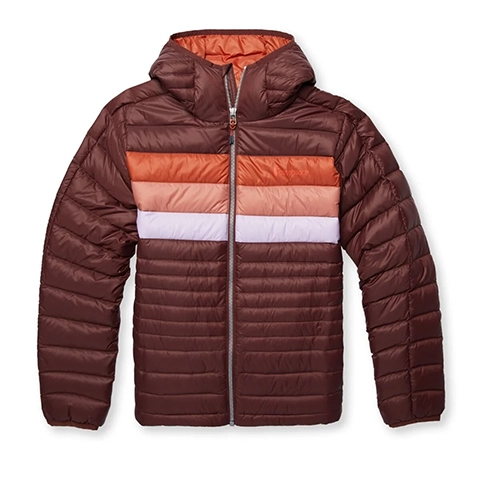
Key Specs
Weight: 14 ounces (397 grams)
Material: 20D nylon ripstop
Price: $$$
PROS
✅ Comfortable
✅ Good fit
CONS
❌ Relatively expensive
❌ Runs small
The Cotopaxi Fuego Jacket has become popular among outdoor enthusiasts seeking versatile insulation in a sustainable package.
Featuring responsibly sourced 800-fill down within a water-resistant shell, it provides warmth far surpassing its slim profile.
However, some users report it runs cooler than expected. While fashionable, its heat retention may not suffice for colder climates without additional layers.
Manufacturing in China also disappoints buyers prioritizing local or domestic production. Nevertheless, most praise its breathable lightweight design and size versatility despite running small.
Where the Fuego jacket truly excels is unfettered freedom of movement. Its unrestricted cut allow comfort on everything from day hikes to backcountry adventures. Multiple pockets keep essentials securely stowed.
While not the hottest option for serious winter pursuits, Cotopaxi’s option delivers balanced warmth, breathability and styling appreciated by casual outdoor fans and early season hikers.
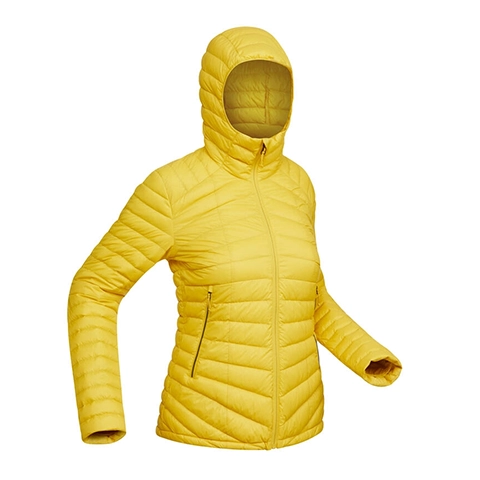
Key Specs
Weight: 9.7 ounces (275 grams)
Material: 15D 100% polyamide
Price: $
PROS
✅ Affordable
✅ Comfortable
CONS
❌ Durability
The Forclaz Ultralight Padded Jacket has earned its reputation as a go-to lightweight insulation piece for hikers. Featuring RDS-certified 800 fill power down, it maximizes warmth for its minimal weight.
While temperature ratings serve as guidelines, wearers note it performing admirably cooler than expected. Soft brushed fabric delivers cozy comfort without bulk. Multiple pockets and an adjustable hem trap precious heat.
Lightweight loft translates to appreciable versatility. This jacket proved wonderfully warm for its barely-there profile and packing size. Freedom of movement on trails remained unrestricted.
However, some users report fragile down clusters damaged during machine washing. Careful hand-washing is highly recommended to maintain the piece’s intended lifetime.
Overall, Forclaz’s Ultralight Padded Jacket earns its keep among top rated down options. Its balancing act of compressible warmth, breathability and versatility provides reliable protection from chill.
When you’re getting ready for a hiking trip, picking the right jacket is super important for your comfort and safety.
Insulation Layer: Your insulated jacket forms the crucial middle layer of your clothing system. It should trap body heat while allowing breathability.
Popular Options: Down and synthetic insulations each have pros. Down is extremely compressible and warm for weight but loses effectiveness when wet. Synthetics perform well when wet but aren’t as lightweight.
Fabric: Breathable fabrics like ripstop nylon, softshells, or fleece keep moisture from getting trapped. Water-resistant options offer extra protection from precip in rougher conditions.
Ventilation: Look for under-arm zips, adjustable hem cords or other venting features to minimize overheating on uphills. Full-zip styles allow easy on/off access.
Fit: Layering requires flexible mobility. Prioritize a trim cut that is not constricting but seals out drafts at cuffs and hem with adjustable closures.
Adaptability: Additional considerations like hoods, handwarmer pockets and high collars enhance usability and comfort across varied temperatures.
Durability: Reinforced fabrics, seams and stress points prolong the jacket’s lifetime through rugged use over time.
By choosing an insulated jacket with these core priorities, you’ll stay cozy on the trail for many adventures to come.
If you want to learn how to choose the right ultralight hiking jacket in detail, check out our post here.
When choosing a women’s insulated hiking jacket, look for waterproof and windproof technical fabrics along with features that provide both functionality and style for outdoor activity. Consider insulated options with down or synthetic fills that retain warmth even when wet. A trim fit with adjustable hem and hood allows unrestricted motion on the trails. Under-zippers, pockets and adjustable collars add breathability, utility and comfort across varied temperatures. Reinforced seams and fabrics built to last rigorous use will keep you cozy for seasons of adventure to come.
For maximum heat retention in an insulated hiking jacket, down insulation is the ideal choice. Down, especially high quality goose or duck down, has extremely high fill power which means it efficiently lofts and traps body heat. Down clusters in small spaces within the insulation to hold warmth close to the body better than synthetic alternatives. While down loses insulating properties when wet, no other material beats its heat retention for the weight. For colder weather hiking, down delivers the most compressible warmth you can pack.
Down and synthetic insulation are different because of where they come from and how well they work. Down comes from geese or ducks and is super light and squishes down small because it traps heat well with its fluffy structure. But if it gets wet, it doesn’t keep you warm. Synthetic insulation, like PrimaLoft, is made by people from materials like polyester. It stays warm even when it’s damp, but it’s not as light as down. Down is great for packing up small and using in dry weather, while synthetic is better if it might get wet. So, it depends on what you’re doing outside and where you’re going.